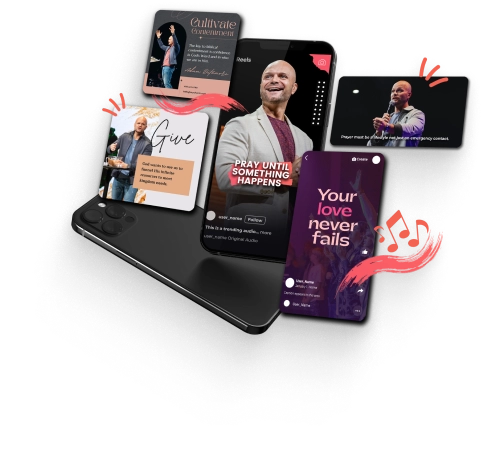How do you captivate a congregation in an era overflowing with distractions? Integrating media tools into church services can transform the way you deliver a powerful sermon. Modern technology isn’t just helpful—it’s vital for engaging your audience and enhancing spiritual messages. From visual aids to interactive apps, the right tools can amplify your message’s impact and keep your congregation connected. This post explores essential tools that can bring your message to life and deepen the worship experience. Stay tuned to discover how these resources can redefine your church service and create a more dynamic and interactive environment.
Understanding the Role of Media in Preaching
In today’s digital age, media plays a significant role in enhancing the way sermons are delivered and received. The integration of media tools into church services doesn’t just modernize worship; it transforms how sermons impact congregations. Whether through visuals, audio, or digital formats, these tools make messages more powerful and accessible. But how exactly does media shape sermon delivery?
Enhancing Sermon Engagement
Have you ever tried explaining a complex idea using only words? It can be challenging. Visual elements act as colorful threads weaving through a tapestry of spoken words, turning complex ideas into something vibrant and memorable. Think about key sermon elements like biblical stories or moral lessons. When backed by images, videos, or dynamic slides, these stories become more vivid and relatable.
Capturing Attention: Visuals add texture and depth to spoken words, grabbing attention like a splash of color on a gray canvas. They draw listeners in and help them focus on the message being conveyed.
Boosting Retention: Just like how a catchy tune stays in your mind, images help cement ideas. They make sermons unforgettable, aiding the congregation in remembering the message long after they’ve left the church.
Facilitating Accessibility
Making sermons available to more people is another vital role of media in preaching. Various formats like podcasts, livestreams, and social media make it possible for sermons to reach beyond the church walls. Here’s how this happens:
Audio and Visual Accessibility: Audio recordings and videos make sermons available for those who can’t attend in person. This is like having church in your pocket, accessible anytime, anywhere.
Global Reach: Platforms like YouTube and Facebook expand the audience, turning a local sermon into a global event. Someone on the other side of the world can experience a powerful sermon just like those seated in the pews.
The use of media in preaching is not just about keeping up with trends; it’s about making meaningful connections and sharing the church’s message more effectively. As churches continue to embrace these tools, they open the door to growth and a more profound impact on their communities.
Essential Media Tools for Powerful Sermons
In today’s digital world, churches are employing technology to make sermons more impactful and engaging. Using the right media tools can help deliver a powerful sermon that captivates the congregation and extends the church’s message beyond its walls. Let’s dive into some essential media tools that can elevate your sermon delivery.
Presentation Software
Presentation software is like a trusty sidekick for any powerful sermon. Programs such as PowerPoint, ProPresenter, and Keynote have been popular choices for churches.
PowerPoint: Known for its user-friendly interface and flexibility, PowerPoint is perfect for adding visuals, bullet points, and transitions that keep the audience engaged.
ProPresenter: This is a favorite among many churches for its ability to seamlessly integrate lyrics, videos, and scripture, supporting a smooth sermon delivery.
Keynote: Designed for Mac users, Keynote provides sleek designs and animations that add a professional touch to sermon presentations.
Each option provides different features that can support sermon delivery in unique ways. What’s most important is choosing a tool that aligns with your sermon goals and enhances your message.
Audio Equipment
Clear sound is critical. Imagine trying to hear a sermon over crackling speakers or a muffled microphone. The right audio equipment is crucial:
Microphones: A quality microphone can enhance voice clarity. Consider wireless options for freedom of movement.
Speakers: Good speakers are vital for delivering a clear and consistent sound.
Mixers: Mixers allow you to control audio levels, ensuring that the sermon is heard without interference.
With the right audio setup, your congregation will hear every word crisply and clearly, making the message much more impactful.
Video Production Tools
Cameras and streaming tools are game-changers for broadcasting sermons beyond the church walls. Here’s why they’re essential:
Cameras: High-definition cameras capture the essence of your sermon, bringing visual insights to your audience.
Streaming Software: Tools like OBS Studio or vMix can help live stream sermons, reaching those who can’t physically attend.
These tools unlock the opportunity to connect with a broader audience, sharing the powerful sermon beyond your immediate community.
Lighting Solutions
The right lighting doesn’t just make things visible; it sets the mood. Proper lighting can enhance the atmosphere of worship, making the sermon the focal point.
Spotlights: These can draw attention to the speaker, enhancing their presence.
Ambient Lighting: Soft, well-placed lighting adds warmth and focus, inviting the congregation into a more intimate worship experience.
When done correctly, lighting becomes a silent partner in emphasizing the sermon’s emotional and spiritual impact.
Social Media Platforms
Social media’s role in sharing sermons and expanding outreach is undeniable. Platforms like Facebook Live and Instagram offer churches a means to broadcast their messages:
Facebook Live: Stream sermons live to your followers, creating an interactive experience with real-time comments and reactions.
Instagram: Share inspirational sermon clips or quotes to engage a younger audience and keep the message alive throughout the week.
Utilizing these platforms effectively can transform a local sermon into a powerful sermon heard worldwide, growing the church’s influence far beyond the pews.
By combining traditional sermon techniques with modern technology, churches can create a sermon experience that resonates deeply with both their congregation and a global audience. Embrace these tools to amplify the impact of your message!
Tips for Integrating Media Effectively
Using media in church services can transform a sermon from simply spoken to a powerful sermon that resonates deeply with the congregation. Integrating media effectively can feel like a dance—each step planned and every move synchronized. To make this work smoothly, there are a few things to keep in mind.
Planning and Coordination
Before the sermon begins, planning and coordination are key. Consider media as the paintbrush that adds color to your message. Here are some steps to ensure everything aligns perfectly with your sermon content:
Start Early: Begin planning your media elements well in advance. Like polishing a stone, this takes time and attention.
Align with Sermon Themes: Ensure images, videos, and audio selections complement your message. They should act as echoes that amplify the words you’re speaking.
Create a Detailed Schedule: Have a clear timeline of when each media element will be used during the service. Think of it as a script for a play—every cue matters.
Training Volunteers and Staff
Your media tools are only as effective as the people handling them. A well-trained team can turn a good sermon into a powerful sermon. Investing time in training is crucial. Here’s how you can foster a team that’s ready to take on media challenges:
Host Regular Training Sessions: Schedule frequent workshops where your team can learn and practice using the equipment. Use real-life scenarios to keep the training engaging and relevant.
Encourage Experimentation: Allow volunteers to explore different media tools. This builds confidence and the skills needed to troubleshoot on the fly.
Create User-Friendly Guides: Develop easy-to-follow guides or videos that team members can refer to when needed. Think of these as roadmaps guiding them through media landscapes.
Feedback and Improvement
Feedback is like a mirror reflecting how your media presentations are received. It offers a perspective that can pave the way for improvement. Here’s how to gather and use constructive feedback:
Ask for Opinions: After services, reach out to congregants. Encourage them to share what they felt worked and what might need tweaking.
Use Digital Surveys: Create simple, anonymous surveys to gather honest feedback. This can provide insights into areas you might not have considered.
Adapt and Evolve: Use the feedback to make informed changes. Small adjustments can have a big impact on creating a more engaging and powerful sermon experience.
Integrating media isn’t just about adding tech elements—it’s about creating a symphony where each note enhances the next. By planning ahead, equipping your team, and listening to your audience, you can craft services that leave a lasting imprint.
Exploring Innovations in Preaching Media
In today’s tech-driven world, delivering a powerful sermon means more than just words from the pulpit. Churches are tapping into new technologies to enrich their services, making sermons more engaging and accessible. From virtual reality to interactive tools, these innovations are changing how congregations experience their faith.
Virtual Reality Experiences
Imagine sitting in your church pew, but instead of just hearing about the Sermon on the Mount, you’re virtually standing there with the crowd. This is the promise of virtual reality (VR) in church services. With VR, congregants can be immersed in biblical scenes or holy settings, creating an experience that words alone might not capture.
VR allows members to:
Step into Biblical stories: Feel the atmosphere, see the scenes, and connect more deeply with the message.
Explore historical sites: Virtually visit the Holy Land or other significant biblical places without ever leaving the church.
Interact with content: Move and engage with the environment in ways that can make sermons unforgettable.
The tech might seem futuristic, but it shores up the timeless message of the Gospel, helping to deliver it in a powerful way.
Interactive Sermon Elements
Ever felt like you had questions during a sermon but no way to ask them? Interactive tools can bring a powerful shift in how sermons are experienced. By integrating real-time polls, Q&A sessions, and more, churches can foster a lively dialogue between the preacher and the congregation.
Here’s how interactive elements enhance sermons:
Polls during sermons: Gauge opinions or check to understand instantly. Imagine asking, “What do you think is the most important teaching of this passage?” and getting real-time feedback.
Live Q&A sessions: Encourage members to send in questions via their devices, creating a dynamic conversation. This makes the sermon feel more like a dialogue than a monologue.
Feedback opportunities: Collect insights on what resonates most, tailoring future messages to better serve the congregation’s needs.
Interactive elements inject energy and engagement into the service, ensuring the message isn’t just heard but lived. These tools foster a community where everyone feels valued and heard, aligning perfectly with the mission of spreading a powerful sermon.
Incorporating these innovations doesn’t mean replacing traditional practices but enhancing them—taking the ancient words of faith and ensuring they continue to inspire in our modern age.
Powerful Sermon Impact
In today’s fast-moving world, delivering messages that captivate and inspire is more important than ever. The mission of a church hasn’t changed, but the ways we reach people sure have. Crafting a powerful sermon that truly resonates requires more than just words; it takes the right tools and strategies to amplify its effect.
Growing the Sermon’s Reach
When you think about growth, it’s not just about numbers. It’s about deepening connections and expanding reach. Tools like Sermon Shots can be incredibly helpful. They allow your message to extend beyond Sunday mornings and into the daily lives of your congregation. Imagine being able to share a snippet of your message on social media, sparking conversations throughout the week. Here’s how that can impact your ministry:
Engagement: Short clips make it easy for people to reflect and discuss, increasing engagement.
Accessibility: Those unable to attend in person can still connect and feel part of the community.
Visibility: More people see your message, leading to potential growth in your congregation.
Making the Message Stick
Even the most powerful sermon can fade if it doesn’t stick with the audience. Just like a memorable tune that plays in your head, a sermon should leave a lasting impression. Consider these methods to make your sermons unforgettable:
Use Visuals: Incorporate images, slides, or videos to illustrate key points. Visual aids help to clarify complex ideas and keep attention.
Tell Stories: Humans are natural storytellers and listeners. Sharing relatable stories can make abstract concepts tangible and relatable.
Interactive Elements: Encourage participation—ask questions, or provide moments for reflection. This interaction makes the congregation part of the message, not just passive listeners.
Remember, a powerful sermon doesn’t just teach; it transforms. By embracing these tools and strategies, your message can reach further and have a deeper impact, nourishing the spirit and lifting the soul. Let these ideas be the torch that carries your message into the hearts and homes of those you serve.





